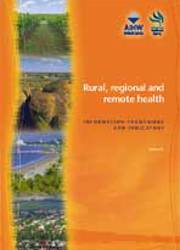Table of contents
- Preliminary material
- Title page and verso
- Contents
- Acknowledgments
- Abbreviations
- Sections
- Introduction
- The Rural Health Information Framework
- Tiers and dimensions of the Rural Health Information Framework
- Health status (Tier 1)
- 1.1 Health conditions
- Chronic diseases
- Injury
- Mental health
- Oral health
- Communicable diseases
- Birth outcomes
- 1.2 Human function
- Prevalence of disability
- Days away from usual activity as a result of illness
- 1.3 Life expectancy and wellbeing
- Disability-adjusted life expectancy (DALE)
- Disability-adjusted life years (DALY)
- Self-assessed health status
- Self-assessed happiness
- 1.4 Deaths
- Death rates
- Perinatal mortality
- Age-specific mortality
- Premature mortality
- Leading causes of death and excess deaths
- 1.1 Health conditions
- Determinants of health (Tier 2)
- 2.1 Environmental factors
- Water
- Sewerage
- Food availability
- Housing
- Recreational and cultural facilities or spaces
- The workplace
- Pollutants
- 2.2 Socioeconomic factors
- Education
- Employment
- Income
- A combined measure of education, income and employment
- 2.3 Community capacity
- Demographic characteristics
- Social issues and social capital
- Services
- Health literacy
- Individuals' perception of risk
- Housing
- Transport
- Cost of living
- Health of businesses
- 2.4 Health Behaviours
- Smoking
- Hazardous and harmful alcohol consumption
- Illicit drug use
- Physical activity/inactivity
- Nutrition
- Sexual practices
- Driving practices
- 2.5 Person-related factors
- Genetically determined diseases
- Specific birth defects caused by environmental factors
- Blood pressure
- Cholesterol
- Overweight and obesity
- 2.1 Environmental factors
- Health system performance (Tier 3)
- 3.1 Effective
- Retrieval for victims of trauma
- STI education in promoting the practice of safe sex
- Immunisation in reducing the incidence of childhood infectious diseases
- Breast cancer and cervical screening in reducing mortality due to cancer
- Medical and surgical treatment in producing good health outcomes
- 3.2 Appropriate
- Female GPs
- Surgical procedure
- Specialist consultations
- Care after surgery
- Aged care
- Hospital accreditation
- Waiting times for elective surgery
- Morbidity managed in general practice
- 3.3 Efficient
- 3.4 Responsive
- Acceptance of health services by Indigenous people
- Confidentiality
- Waiting times by public patients for elective surgery
- Response time in emergency departments
- Bulk billing
- Waiting times for allied health workers
- Waiting time for results of diagnostic tests
- Closed books
- Satisfaction
- 3.5 Accessible
- Distance
- Discrimination
- Financial constraints
- Health facilities and health professionals
- Disability services
- Continuity
- 3.6 Safe
- Medical/surgical misadventure
- Survival rates in intensive care units
- 3.7 Continuous
- Care planning and case conferencing
- 3.8 Capable
- 3.9 Sustainable
- Training of the rural health workforce
- Recruitment and retention of the rural health workforce
- Hours worked and age of health workers
- On-call work
- 3.1 Effective
- Health status (Tier 1)
- Indicator documentation
- Health status (Tier 1)
- 1.1 Health conditions dimension
- Prevalence of chronic diseases
- Prevalence of injuries
- Prevalence of depressive, anxiety and substance abuse disorders
- Decayed, missing and filled teeth
- Communicable diseases
- Birth outcomes
- 1.2 Human function dimension
- Prevalence of disability
- Reduced activity because of illness
- 1.3 Life expectancy and wellbeing dimension
- Life expectancy
- Self-assessed health status
- Happiness
- 1.4 Deaths dimension
- Overall mortality
- Perinatal mortality
- Age-specific mortality
- Premature mortality
- Leading causes of death and excess deaths
- 1.1 Health conditions dimension
- Determinants of health (Tier 2)
- 2.1 Environmental factors dimension
- Fluoridated water
- 2.2 Socioeconomic factors dimension
- Educational status of the adult population
- High school retention rates
- Progression from school to university
- Workforce and employment
- Household income
- Gap between rich and poor
- Sources of income
- SEIFA
- 2.3 Community capacity dimension
- Demography
- Dependency ratio
- Internal migration
- Fertility
- Community safety
- Perception of risk
- Housing tenure
- Overcrowding in households
- Transport
- Cost of living
- Business activity
- 2.4 Health behaviours dimension
- Tobacco
- Alcohol
- Illicit drugs
- Physical activity and inactivity
- Nutrition
- Sexual practices
- 2.5 Person-related factors dimension
- Genetically determined diseases
- Specific birth defects
- Overweight/obesity
- 2.1 Environmental factors dimension
- Health system performance (Tier 3)
- 3.1 Effective dimension
- Immunisation rates
- Breast cancer and cervical screening participation rate
- 3.2 Appropriate dimension
- Female GPs
- Specialist hospital procedures
- Specialist consultations
- Aged care
- Morbidity managed in general practice
- 3.3 Efficient dimension
- 3.4 Responsive dimension
- Waiting times for elective surgery
- GP Bulk billing
- 3.5 Accessible dimension
- Distance to medical services
- Numbers of health workers
- Hospital separations and bed days
- Primary care medical consultations
- Dental consultations
- Prescription
- Access to disability services
- 3.6 Safe dimension
- Surgical and medical misadventure
- 3.7 Continuous dimension
- Care planning and case conferencing
- 3.8 Capable dimension
- Hospital accreditation
- 3.9 Sustainable dimension
- Workforce in training
- GP retention
- Hours worked and age of health workers
- 3.1 Effective dimension
- Health status (Tier 1)
- Data gaps (76KB PDF)
- Generic issues
- Indigenous identification
- Surveys
- Geographic classification
- Other issues
- Issues for which it is not possible to report and why (by each dimension of the framework)
- Data sources used in reporting against the indicators and their constraints
- Strategies to overcome data constraints
- Generic issues
- End matter (97KB PDF)
- References
- Appendix 1
- Appendix 2



